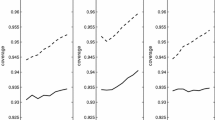Summary
The aim of this paper is to propose new selection criteria for the orders of selfexciting threshold autoregressive (SETAR) models. These criteria use bootstrap methodology; they are based on a weighted mean of the apparent error rate in the sample and the average error rate obtained from bootstrap samples not containing the point being predicted. These new criteria are compared with the traditional ones based on the Akaike information criterion (AIC). A simulation study and an example on a real data set end the paper.



Similar content being viewed by others
References
Box, G. E. P. and Jenkins, G. M. (1969),Time series Analysisforecasting and control, Holden day.
Buehlmann, P. (1997), Sieve Bootstrap for Time Series,Bernoulli,3, 123–148.
Carlstein, E., Do, K.-A., Hall, P., Hesterberg, T. and Kuensch, H. R. (1998), Matched-block Bootstrap for Dependent Data,Bernoulli,4, 305–328.
Chan, K. S., Petruccelli I D., Tong H. and Woolford S. W. (1985), A Multiple Threshold AR(1) Model,Journal of Applied Probability,22, 267–279.
Chan, K. S. (1993), Consistency and limiting distribution of the least squares estimator of a threshold autoregressive model,Annals of Statistics,21, 520–533.
Cheng, B. and Tong, H. (1992), On Consistent Nonparametric Order Determination and Chaos,Journal of Royal Statistical Society,B 54, 427–449.
De Gooijer, J. G. (2001), Cross-validation Criteria for SETAR Model Selection,Journal of Time Series Analysis,22, 267–281.
Efron, B. and Tibshirani, R. J. (1993),An Introduction to the Bootstrap, Chapman & Hall.
Hall, P., Horowitz, J. L. and Jing, B.-Y. (1995), On Blocking Rules for the Block Bootstrap and Dependent Data,Biometrika,82, 561–574.
Hjorth, J. S. U. (1994),Computer Intensive statistical Methods-Validation, model selection and bootstrap, Chapman & Hall.
Kuensch, H. R. (1989), The Jackknife and the Bootstrap for General Stationary Observations,The Annals of Statistics,17, 1217–1241.
Marsaglia, G. (1984), A Current View of Random Number Generators,The Proceedings of the 16th Symposium on the Interface, Atlanta, Elsevier Press.
Moran, P. A. P. (1953), The statistical analysis of the Canadian lynx cycle, I:structure and prediction.Australian Journal of Zoology,1, 163–173.
Petruccelli, J. D. and Woolford, S.W. (1984), A threshold AR(1) model,Journal of Applied Probability,21, 270–286.
Shao, J. (1996), Bootstrap Model Selection,Journal of American Statistical Association,91, 655–665.
Schoier, G. (1999), Strong consistency of a multiple regime threshold AR(1) model,Journal of Italian Statistical Society,8, 75–82.
Tong, H. and Lim, K. S. (1980), Threshold Autoregression, Limit Cycles and Cyclical Data,Journal of Royal Statistical Society,B 42, 245–292.
Tong, H. (1983),Threshold Models in Non-Linear Time Series Analysis, Lecture Notes in Statistics, Springer-Verlag.
Tong, H. (1990),Non-Linear Time: A dynamical System Approach, Oxford University Press.
Tsay, R. S. (1989), Testing and Modeling Threshold Autoregressive Processes,Journal of American Statistical Association,84, 231–240.
Wong, C. S. and Li, W. K. (1998), A Note on the Corrected Akaike Information Criterion for Threshold Autoregressive Models,Journal of Time Series Analysis,19, 113–124.
Author information
Authors and Affiliations
Rights and permissions
About this article
Cite this article
Öhrvik, J., Schoier, G. SETAR model selection-A bootstrap approach. Computational Statistics 20, 559–573 (2005). https://doi.org/10.1007/BF02741315
Published:
Issue Date:
DOI: https://doi.org/10.1007/BF02741315




